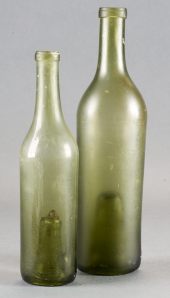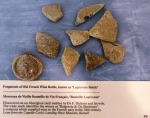
 The Laperouse Bottle - F.P. Dickson, 5th May 1980
The Laperouse Bottle - F.P. Dickson, 5th May 1980
The pieces of this old French wine bottle are very probably a relic of the visit by Laperouse to Botany Bay with his ships L’astrolabe and La Boussole in 1788.
In the course of my archaeological field work on the Kurnell Peninsula the fragments of the bottle were found on the surface of an Aboriginal midden. The site was near the north eastern end of an extensive range of middens at Quibray described by Doak and Macaulay-Doyle(1827) and by Rolfe (1931). When examined by these authors half a century ago the middens had already been severely damaged by natural and human action, including those of numerous collectors who took away the best looking artefacts then visible.
It is not possible to say when the site was first occupied but it must have been several thousand years ago as a carbon date for some bones in one of the middens(ANU-261) gives an age of 2210+/- 330 BP. Until recently the biggest middens were in a line parallel and close to the shore of Quibray Bay. In 1931 the shoreline was only about 200m distant but since then what Rolfe called “the advancing wall of sand” has covered them and passed on so that the middens now exposed are some 500m from the bay shore. Evidently occupation continued into the 19th century as both Rolfe and I found post-contact material and evidence (Rolfe 1931:61 and Dickson 1971:60) that the Aboriginals worked bottle glass to make small implements.
In all 28 pieces of the French bottle were collected, all of them so much weathered and partially devitrified to a bronze colour, even on the fracture surfaces, that they were not at first sight recognisable as glass. As some of the pieces were a square centimetre or less in area it appears that the bottle was broken where the fragments were found. As might be expected the bottom parts were not found as the thick glass there was the most useful for flaking into implements.
One piece carries a nearly intact vintner’s prunt which makes positive identification possible. This is a circular badge made from a blob of glass welded to the bottle below the shoulder and stamped with a hot metal die. Within a dotted circle is an emblem in the form of a length of vine stem with two leaves and a bunch of grapes. Surrounding the emblem is the legend BALGUERIE & CIE BORDEAUX.
Many other bottle fragments and some whole bottles have been found on the peninsula, ranging in age from contemporary to pieces that have been dated by the Museum of Applied Arts and Sciences to about 1820. Obviously these older bottles would have reached here a few years after they were made. The extent of patination on these fragements varied considerably but none seemed to have been weathered to the same extenet as the Balguerie bottle and, as it looked older than any of the others, this glass was also sent in to the Museum where it was dated to the second half of the 18th century.
This date prompted enquiries at the French Consulate in Sydney and in Bordeaux. The Consul-General personally recalled the firm of Balguerie as still in existence in 1920. It appears that they were an old and well-known firm and suppliers of wine to the French navy. From the recods of the Departemewnt de la Gironde it seems that the proprietor of the firm at the relevant time was Jean-Pierre Balguerie (1731-1806). Jean-Etienne, born in 1756 and known as Balguerie Junior, was a senior naval officer who embarked on a new career in 1788 as a merchant. In 1817 he met the costs of an expedition around the world by one of his ships, Le Bordelais, commanded by the Mrquis de Roquefeuil. Evidently the Balgueries had close connections with the French Navy.
Now, two centuries later, one cannot undertake to prove more than this is the oldest identifiable French winne bottle yet found in Australia. But the dates and the circumstances are right for the bottle to have come to Botany Bay in one of the Laperouse ships. No other ships than Cook’s Endeavour and the First Fleet are know to have been in the bay in the relevant period. It seems unlikely that in a time of general hostiltity and wars between Britain and France wither the Endeavour or any of Phillip‘s ships would have carried the luxury of Bordeau wine. Doubtless Baudin had wine aboard Le Naturaliste and Le Geographe in 1802 but would probably have conserved his supplies while enjoying the hospitality of Port Jackson.
One can make arguments about all these and other possibilities but the circumstantial evidence seems to point with sufficienet probability to the Laperouse expedition.
Dickson, F.P. 1971 Old glass from Kurnell. Mankind 8, 1:60-1
Doak, J. and Macaulay-Doyle, C. 1927 The White heart of Cronulla, , Sydney University Science Journal 1927:30-40
Rolfe, J.S. 1931 An Aboriginal midden at Quibray Bay, Mankind 1,2: 36-7 and 1,3: 61-3
About the Author Dr Frank Dickson, Archaeologist
Dr Dickson served on the Captain Cook’s Landing Place Historic Site Advisory Committee from 1978 to 1983 and was Chairman from 1981. His thorough knowledge of the pre-hisoty, and familiarity with the topography of the Kurnell peninsula made him a pre-eminent authority on the subject, on which he was the author of numerous articles, including notably a background paper on “Aboriginal Prehistory of Boany Bay” written for The Botany Bay Project: A handbook of the Botany Bay Region. Sydney, the Botany Bay Project Committee, 1974; a memorandum entitled “The Laperouse Bottle”, (May, 1980); and a book entitled Aboriginal Stone Hatchets.

You must be logged in to post a comment.